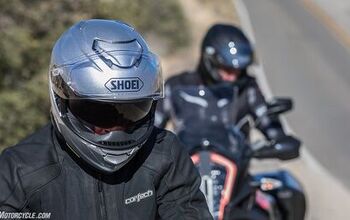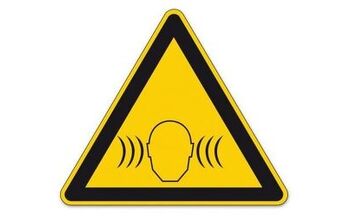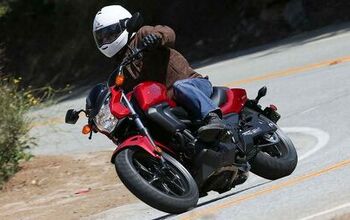Road Conditions Quiz For Motorcyclists - Motorcycle.com
Road Conditions Quiz For Motorcyclists
Riding a motorcycle safely and in control means not just better bike handling; it also means judging road conditions.
No matter what your experience level, riding on busy roads – which often have poor surfaces – can challenge any rider.
According to the Motorcycle Safety Foundation and other instructors, the best attitude to adopt is to become a “life long learner.” Enrolling in a rider’s class from time to time, as well as proactive self-learning are healthy continuing education habits to get into.
With experience, riders learn the importance of scanning the road, and they develop greater awareness of conditions as they ride, including ability to estimate traction, which has been described as “reading” types of pavement.
| Allstate Insurance On Rider Safety |
| Our friends at Allstate Motorcycle Insurance know a thing or two about motorcycle safety. In addition to Motorcycle.com‘s safety series, Allstate Motorcycle Insurance has its own valuable safety information to share.* Motorcycle Awareness: Safety Tips from Allstate Motorcycle Insurance * Rider Safety: Staying Alert on Familiar Routes * Rider Training: Be Prepared and Carry These Essentials |
Gauging traction is critical! With only two thin tires, it is more important for riders than drivers of four-wheelers.
Recognizing when clean pavement is slick, or offers average traction, or is especially grippy, as well as noticing if it is littered with sand, gravel, oil increases chances for safety and control.
According to a study of motorcycle crashes done by the University of Southern California and the U.S. Department of Transportation, about 75 percent of accidents involved collision with another vehicle, and 25 percent were single-vehicle cases where the rider simply fell, or hit something.
Rider error was the cause of about two-thirds of all single-vehicle accidents. The typical error was a “slideout” or a fall due to over braking or running wide on a curve due to excess speed or under cornering.
Road Conditions Rider Quiz
Answers Below
1. If you are caught riding in strong or severe winds, you should:
a) Steer away from the wind so it pushes you safely.
b) Steer into the wind as much as possible.
c) Keep a good grip on the handlebars, a firm planting of your feet on the pegs and keeping your arms and shoulders flexible.
d) A and C.
e) B and C.
2. If it is wet or raining, when using the brakes, it is best to:
a) Pump both brakes alternately.
b) Pump the front, and lightly tapping the rear.
c) Use only the back brake, not touching the front brake.
d) Use both brakes like normal, as long as you are straight up and down.
e) Use both brakes carefully, progressively and smoothly.
3. If riding on gravel-strewn roads:
a) Slightly accelerate to better accommodate clearing the gravel.
b) Slow down as needed.
c) Meander back and forth to dodge the bulk of the gravel if you can.
d) Never use the brakes.
e) Carefully use the brakes.
f) A and D.
g) B and E.
4. When riding on gravelly road surfaces, you should:
a) Watch the front wheel closely.
b) Keep your eyes up looking ahead to where you want to go.
c) Increase your speed slightly.
d) Decrease your speed slightly as needed.
e) B and D
f) A and C.
5. When attempting to slow on a straight section of gravelly road, you should:
a) Use only the back brakes.
b) Use both brakes gently.
c) Pump the brakes.
d) Don’t use the brakes at all.
6. When cornering and you realize you are on sandy or graveled road surface:
a) Straighten up and go into the other lane as long as no cars are coming.
b) Try to steer sharply and avoid the gravel.
c) Try not to use the brakes.
d) Gently use the brakes.
7. If you see a pothole coming:
a) Slam on the brakes so you don’t hit it too hard.
b) Swerve as hard as you can.
c) Steer around it if you can, and if you can’t avoid it, hit it as squarely as possible.
d) Speed up so you will clear it better.
e) Stand up and pull back slightly on the handlebars to lighten the front end.
f) Either C or E, depending on circumstances.
8. The following usually offers the best grip:
a) Weathered and oily asphalt.
b) New asphalt.
c) Old dry asphalt.
d) Concrete.
e) Could be either B or C.
9. If you have to make a swift evasive turn left, at speed, you:
a) Press hard on the right grip.
b) Press hard on the left grip.
c) You lean left hard and do not press the bars either way.
d) You press on the right grip, and lean left as well as you can.
10. When riding after dark, the following is the best all around advice for safety:
a) Never exceed the speed limit.
b) Slow down below the speed limit.
c) Ride normally.
d) Do not outrun your headlights.
e) Do not ride after dark unless you absolutely have to.
11. If it starts to rain:
a) Find a bridge and pull under it.
b) If there are no bridges, pull over and seek shelter if you can.
c) At least slow down, especially in the first 10 to 30 minutes to allow the road to get “washed” clean.
d) Don’t do anything different than if it were dry.
12. In worn out, rutted asphalt at intersections:
a) The center third of the lane is most slippery and oily and so you should stay either to the right or left third.
b) Even though it is more oily, the center is less worn, and statistically the safest pavement.
c) It makes no difference which third you ride as long as you are careful.
13. If you hit a big piece of debris on the road:
a) You should take the bike to a motorcycle shop for them to inspect it.
b) You should schedule an oil change.
c) If you don’t hear any strange noises, check the bike after the ride.
d) Pull over and inspect the bike’s tires, and undercarriage, etc.
14. Generally, which could potentially be more hazardous while riding:
a) A front flat tire because steering will be most affected.
b) A rear flat tire because when the bike is upset, you usually want to use the rear brake, but can’t.
c) It makes no difference, both tires are equally important.
15. When crossing railroad tracks:
a) Accelerate slightly, while hitting them at a slight angle, if possible.
b) Attempt to hit them square, and accelerate as you approach them.
c) Ride over them like normally, and don’t worry, modern motorcycle tires easily cross them, and it is no longer necessary to exercise caution.
d) Attempt to cross the tracks approaching at a 90-degree angle under normal power, or a little slower if possible.
16. When crossing the occasional “metal grate” bridge:
a) If you speed up a little, it actually smoothes out the ride.
b) Never attempt to cross a metal grate bridge because studies show they are usually too slippery and could cause a fall.
c) As you approach, slow down as much as practical, neither on the gas, nor on the brakes, and ride it out as straight up and down as you can.
d) You must be very careful on these types of bridges. Even in dry conditions they can be slippery, and they are extremely slippery when wet.
e) B and D
f) C and D
17. If road construction crews are re-routing traffic:
a) There is no cause for concern; construction managers are licensed by federal highway safety officials, and know how to safely divert traffic safely.
b) It is advisable to avoid construction re-routes. Riders have been injured and killed, and you should avoid construction zones any time it is possible.
c) Slow down, use the front and rear brakes gently as you come near, and ride within the posted construction zone speed limits, using caution.
d) Slow down, use the front and rear brakes gently as you come near, and ride 10 mph below posted construction zone speed limits. Do not worry if motorists seem impatient.
18. What is the best way to handle roadways in process of being resurfaced that have been “chewed up,” or made rough by a roadway surface removal machine?
a) Stop, and find a way to turn around. Do not ride on these surfaces.
b) Slow down to a speed about half the posted speed limit, and take your time getting through. Do not let tailgating cars concern you.
c) Absolutely do not use the brakes on these surfaces.
d) Use the front sparingly, concentrating on the rear brake on these surfaces
e) Ride slower, stay calm, and treat as rain grooves. Use both brakes carefully and be aware that the handlebars might oscillate from side to side which will get worse with higher speeds.
19. If you encounter long sections of patched or repaired pavement:
a) Try to stay on the new, patched sections.
b) Do not ride on the new, patched sections.
c) Ride wherever it looks smoothest, as long as you are steady, not meandering too much. Don’t ride along the seams between old and new sections.
d) It does not matter what line you take. Road crews must do repairs within inspected standards.
e) Avoid patched sections. If you have to stop, and turn around, it’s OK.
20. When crossing large swaths of painted markings (such as crossways, etc.):
a) Use extreme caution. Stop and turn around if possible.
b) These painted sections are super slippery when wet, and while rideable, should be avoided if possible.
c) These sections are not as slippery as some think because they have sand mixed in with the paint for traction.
d) Use the brakes as normal to gently slow down to 15-20 mph below the limit, and otherwise do not worry about the painted sections.
e) Make sure you are as close to vertical as possible. If you need to use the brakes while crossing through the painted road, use them gently. When wet, these surfaces are more slippery, but rideable.
21. Regarding “edges traps” some regions have cut into some of the shoulders of their roads, they:
a) Are not a problem to modern motorcycles.
b) Often times are not marked and especially hard to see in the dark.
c) Can cause a crash if you try to re-enter the road from the shoulder and hit the edge at the wrong angle.
d) Are usually well marked.
e) B and C.
f) A and D.
Answers
1. e
2. e
3. g
4. e
5. b
6. c
7. f
8. e
9. b
10. d
11. c
12. a
13. d
14. a
15. d
16. f
17. c
18. e
19. c
20. e
21. e
More by Jeff Cobb



























Comments
Join the conversation